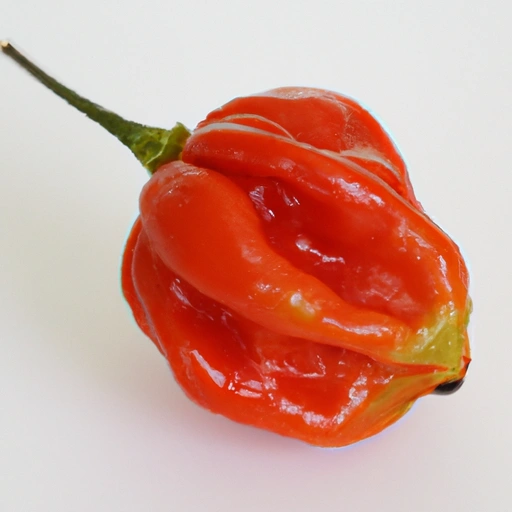Scotch Bonnet Pepper
Description

The Scotch Bonnet pepper, also known as Bonney peppers or Caribbean red peppers, is a variety of chili pepper named for its resemblance to a Tam o' Shanter hat. It is one of the hottest peppers in the world and is closely related to the habanero but often has a sweeter flavor. The pepper typically measures between 100,000 to 350,000 on the Scoville Heat Scale, making it a fiery addition to any dish. In recipes, Scotch Bonnet peppers are often used in very small amounts, and chefs recommend handling them with gloves due to their potent heat.
Common uses
Scotch Bonnet peppers are widely used in hot sauces, jerk seasoning, curries, and marinades. They are also utilized in fresh salsas and chutneys to add a spicy kick. Due to their intense heat, they are often used sparingly in culinary applications.
Nutritional value
Calories
Scotch Bonnet peppers are low in calories, with a typical pepper having just about 18 calories (75 kJ).
Protein
These peppers contain a minimal amount of protein, roughly 0.86 grams per 100 grams.
Fat
Scotch Bonnet peppers are virtually fat-free, containing less than 0.5 grams of fat per 100 grams.
Carbohydrates
The primary macronutrient in Scotch Bonnet peppers is carbohydrates, with about 7.7 grams per 100 grams.
Vitamins
They are a rich source of Vitamin C, providing about 242.5 mg per 100 grams, and also contain small amounts of Vitamins A and B.
Minerals
These peppers contain various minerals such as potassium, magnesium, and iron in trace amounts.
Health benefits
Scotch Bonnet peppers are known for their high Vitamin C content, which is beneficial for immune system health. Capsaicin, the compound responsible for their heat, has been linked to pain relief and may boost metabolism. However, most benefits are obtained when consumed in moderation due to their intense spiciness.
Potential risks
Due to their high capsaicin content, consuming Scotch Bonnet peppers can cause digestive irritation for some individuals. Their extreme heat can also cause discomfort if not handled properly, so it's advised to wear gloves when preparing them and to avoid touching sensitive areas such as the eyes.
Common recipes
Scotch Bonnet peppers are a key ingredient in Caribbean jerk dishes, as well as in pepper sauces and condiments. They are also used to spice up stews, soups, and rice dishes.
Cooking methods
To mitigate their heat while cooking, Scotch Bonnet peppers can be de-seeded and the white pith removed. They can be sautéed, roasted, or used raw, depending on the recipe.
Pairing with other ingredients
These peppers pair well with tropical fruits such as mango and pineapple, which can balance their heat. They also complement the flavors of coconut milk, allspice, thyme, and garlic in savory dishes.
Summary
Scotch Bonnet peppers are an essential ingredient for those who love spice in their food. With their sweet, fruity undertones and fiery heat, they provide a unique flavor profile that enhances a variety of dishes across different cuisines. While rich in certain vitamins and beneficial in small quantities, these peppers must be used cautiously to prevent overpowering a dish or causing discomfort.